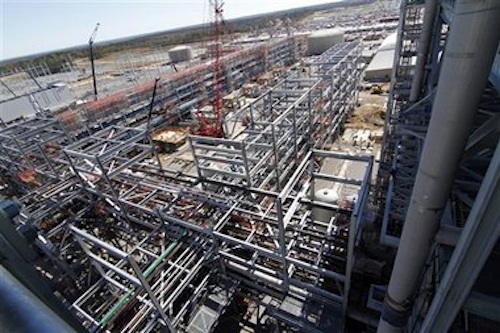You may have heard about the Kemper County (MS) power plant — here’s the Wiki for it, for good measure — as it could be a major step forward in the climate change battle. Here’s the basic situation: the plant converts coal into gas. The gas powers turbines, which create electricity. There is resulting carbon dioxide from this process, but rather than releasing it, the Kemper Project turns it into a liquid, and said liquid is used to help extract oil from nearby fields. It’s been called “the plant of the future.” It should cut emissions by 65 percent, and has been classified by some as the only true carbon capture facility that will operate in the U.S. when it’s finished.
There are obviously concerns — the price tag went from $1.8 billion to $5.2 billion, for example, per a recent issue of Bloomberg Businessweek. The energy produced is ultimately $6,800/kilowatt, which is six times more than the kilowatt cost of a modern natural gas plant; that will increase utility bills in the area (187K people or so) by 22 percent. Additionally, the area of construction is near a good deal of wetlands and streams that environmental groups fear will be compromised. Kemper bills itself as a zero liquid run-off facility, so these concerns seem to be somewhat unfounded, but they still need to be considered.
It looks like the plant’s completion date has been pushed to 2015 (a year later than anticipated) with additional construction costs around $184 million, and the overall project is hurting Southern Company’s (the people building it) stock. As The Washington Post put it recently, “the only thing this plant is burning now is money.”
This is an interesting case study because it clearly has the potential to be something that becomes a norm in the future: when finished (May 2015, ideally), it may serve as the cleanest coal facility in the world. The issue, of course — the issue with everything, ultimately — is how to get the technology to a place where the cost can come down. Clean coal and reduced emissions are crucial for society, but people will care less about that if it leads to 30-percent increases in their utility bills (sadly, ’tis basic psychology). Here’s a snapshot of the problem — fiscal vs. future — via WaPo:
Duke Energy’s Mohler says his emphasis has shifted from carbon sequestration to “carbon utilization.” He’s looking at technologies that would use CO2 to grow algae that could then be used in biofuels. That approach would capture a tiny fraction of the output of a coal plant, but it might make financial sense, Mohler says.
As for the larger picture, Mohler is torn.
“As a utility executive, my fiduciary duty is to my company and investors,” he says. “But as a global citizen, if we’re really serious about this issue we need to think about technologies, and not just in the United States.”
For a bigger-picture look at some of these issues, this is a good read from 2010.

“$6,800/kilowatt” doesn’t look right. And it is not a unit of energy.
I pay $0.11 / Kilo-watt-hour
I actually got that stat from Bloomberg Businessweek. I’ll check on it, though.